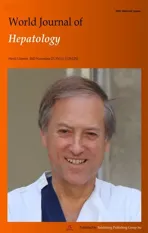Letter to editor ‘Non-invasive model for predicting high-risk esophageal varices based on liver and spleen stiffness’
2023-04-25XinGaoXiaoYanGuoLongBaoYangZhongCaoWeiPanZhangYaTaoWangChenYuLiuDanYangZhangYanWang
Xin Gao,Xiao-Yan Guo,Long-Bao Yang,Zhong-Cao Wei,Pan Zhang,Ya-Tao Wang,Chen-Yu Liu,Dan-Yang Zhang,Yan Wang
Abstract This letter to the editor relates to the study entitled "Non-invasive model for predicting high-risk esophageal varices based on liver and spleen stiffness".Acute bleeding caused by esophageal varices is a life-threatening complication in patients with liver cirrhosis.Due to the discomfort,contraindications,and associated complications of upper gastrointestinal endoscopy screening,it is crucial to identify an imaging-based non-invasive model for predicting high-risk esophageal varices in patients with cirrhosis.
Key Words: Cirrhosis;High-risk esophageal varices;Non-invasive prediction model;Spleen stiffness measurement;Liver stiffness measurement;Upper gastrointestinal endoscopy
TO THE EDITOR
We read with interest the retrospective study by Yanget al[1],which is titled "Non-invasive model for predicting highrisk esophageal varices based on liver and spleen stiffness".The results of this study highlight the potential use of liver stiffness measurement (LSM) and spleen stiffness measurement (SSM) for predicting high-risk esophageal varices (HEVs)in patients with cirrhosis.
Portal hypertension (PH) is a common and significant complication in patients with cirrhosis,leading to esophageal varices (EVs)[2].Hepatic venous pressure gradient and upper gastrointestinal endoscopy (UGE) are considered the gold standard for assessing the severity of PH and the risk of EV bleeding.However,due to their invasiveness,discomfort,and high cost,it is crucial to identify non-invasive markers for screening HEVs in cirrhotic patients[3,4].In recent years,LSM and SSM using transient elastography (TE),acoustic radiation force impulse elastography,two-dimensional shear wave elastography,and magnetic resonance elastography have been proven to be accurate diagnostic tools for evaluating chronic liver disease with liver fibrosis as well as predicting the presence or absence of HEVs[5].
We want to emphasize a few points about this study: In this study,the authors used Baveno VI as a comparator but did not include the more comprehensive Baveno VII as a comparator[6].At the same time,the authors did not distinguish between the M and XL models of the FibroScan probe when measuring LSM and SSM,which may have an impact on the comprehensiveness and accuracy of the results[7].Second,patients with current/past clinical cirrhosis were included in this study,but the proportion of patients with decompensated cirrhosis in this cohort is unclear,since the non-invasive measures used here were primarily used for endoscopic triage of patients with compensated cirrhosis.No guidelines recommend its use in patients with clinical decompensation,for whom screening by UGE is recommended.Additionally,while all subjects included in this study had viral hepatitis cirrhosis,they did not consider the possible effect of antiviral treatment on TE measurements.Furthermore,the effect of alcoholic and nonalcoholic steatohepatitis on cirrhosis has been underrepresented,which may limit the external validity of our findings across diverse populations and settings.To enhance the reliability of the conclusions of this study,we recommend a study with a larger sample size,especially in patients with nonalcoholic steatohepatitis and alcohol-induced cirrhosis,to verify the validity of the model in patients with different types of cirrhosis.Such a study would help improve the convenience and operability of clinical practice and more accurately assess the condition of patients.
The highlight of this study is that all enrolled patients completed UGE testing.Additionally,when SSM is unavailable or unsuccessful,the Baveno VI criterion can be used as a reasonable alternative according to Yanget al[1] Moreover,a screening strategy based on LSM and SSM could reduce the workload of endoscopy and optimize the use of health care resources while minimizing risk and patient discomfort.In summary,we acknowledge the efforts and contributions made by the authors.Furthermore,we recommend further prospective validation to facilitate future research on this topic.
ACKNOWLEDGEMENTS
We thank all the participants in this study.
FOOTNOTES
Author contributions:Gao X contributed to this work;Guo XY,Wei ZC,Liu CY wrote this letter;Yang LB,Zhang P,Zhang DY edited this letter,and Wang YT and Wang Y revised this letter.
Supported bythe Shaanxi Provincial Key Research and Development Plan,No.2020SF-159.
Conflict-of-interest statement:All the authors declare that they have no conflict of interest.
Open-Access:This article is an open-access article that was selected by an in-house editor and fully peer-reviewed by external reviewers.It is distributed in accordance with the Creative Commons Attribution NonCommercial (CC BY-NC 4.0) license,which permits others to distribute,remix,adapt,build upon this work non-commercially,and license their derivative works on different terms,provided the original work is properly cited and the use is non-commercial.See: https://creativecommons.org/Licenses/by-nc/4.0/
Country/Territory of origin:China
ORCID number:Xin Gao 0009-0003-6062-7390;Xiao-Yan Guo 0000-0003-0487-1471;Ya-Tao Wang 0000-0002-4111-566x;Yan Wang 0000-0002-1127-9102.
S-Editor:Liu JH
L-Editor:A
P-Editor:Cai YX
杂志排行
World Journal of Hepatology的其它文章
- Metabolomics in chronic hepatitis C: Decoding fibrosis grading and underlying pathways
- Evaluation of a protocol for rifaximin discontinuation in critically ill patients with liver disease receiving broad-spectrum antibiotic therapy
- Global burden of cirrhosis and other chronic liver diseases due to nonalcoholic fatty liver disease,1990-2019
- Function of macrophage-derived exosomes in chronic liver disease:From pathogenesis to treatment
- Risk of hepatitis B reactivation in patients with myeloproliferative neoplasms treated with ruxolitinib
- Budd-Chiari syndrome in children: Challenges and outcome
